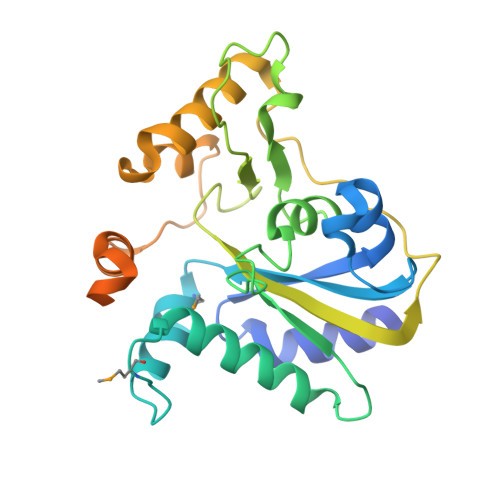Structure of MMACHC reveals an arginine-rich pocket and a domain-swapped dimer for its B12 processing function.
Froese, D.S., Krojer, T., Wu, X., Shrestha, R., Kiyani, W., von Delft, F., Gravel, R.A., Oppermann, U., Yue, W.W.(2012) Biochemistry 51: 5083-5090
- PubMed: 22642810
- DOI: https://doi.org/10.1021/bi300150y
- Primary Citation of Related Structures:
3SOM - PubMed Abstract:
Defects in the MMACHC gene represent the most common disorder of cobalamin (Cbl) metabolism, affecting synthesis of the enzyme cofactors adenosyl-Cbl and methyl-Cbl. The encoded MMACHC protein binds intracellular Cbl derivatives with different upper axial ligands and exhibits flavin mononucleotide (FMN)-dependent decyanase activity toward cyano-Cbl as well as glutathione (GSH)-dependent dealkylase activity toward alkyl-Cbls. We determined the structure of human MMACHC·adenosyl-Cbl complex, revealing a tailor-made nitroreductase scaffold which binds adenosyl-Cbl in a "base-off, five-coordinate" configuration for catalysis. We further identified an arginine-rich pocket close to the Cbl binding site responsible for GSH binding and dealkylation activity. Mutation of these highly conserved arginines, including a replication of the prevalent MMACHC missense mutation, Arg161Gln, disrupts GSH binding and dealkylation. We further showed that two Cbl-binding monomers dimerize to mediate the reciprocal exchange of a conserved "PNRRP" loop from both subunits, serving as a protein cap for the upper axial ligand in trans and required for proper dealkylation activity. Our dimeric structure is supported by solution studies, where dimerization is triggered upon binding its substrate adenosyl-Cbl or cofactor FMN. Together our data provide a structural framework to understanding catalytic function and disease mechanism for this multifunctional enzyme.
- Structural Genomics Consortium, NIHR Oxford Biomedical Research Unit, University of Oxford, Oxford, U.K.
Organizational Affiliation:






















